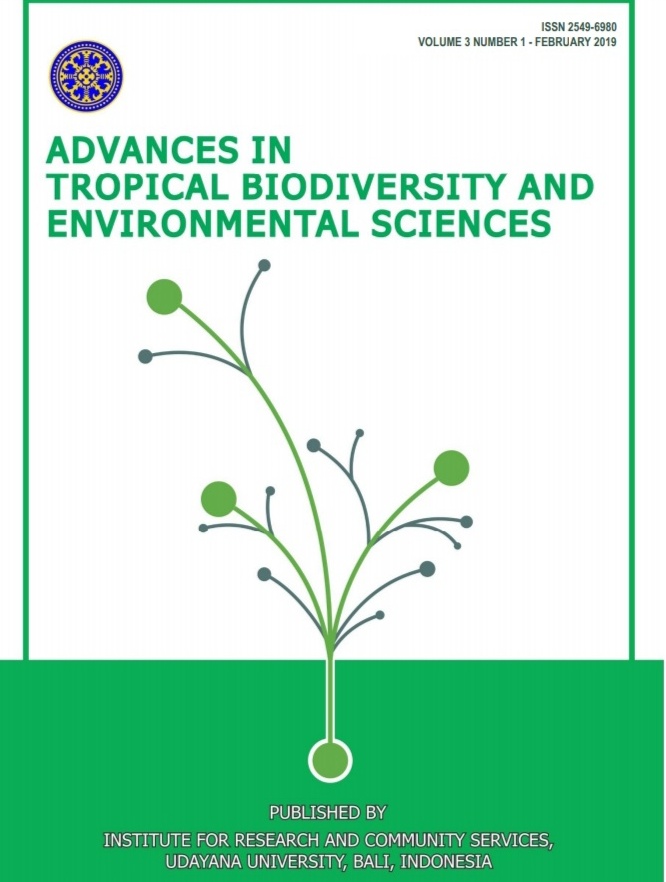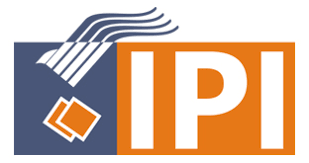Seagrass (Enhalus acoroides) as an Heavy Metal Bioindicator on Biomonitoring Water Quality in Sanur Beach Bali
Abstract
Abstract. Heavy metal contamination is a major threat for marine ecosystem that directly affecting the organisms’ life. Some of marine organisms have an ability to response the heavy metal contamination in water, and could be used as bio-indicator. One of them is seagrass that used in this study to evaluate the water quality in Sanur beach. This study was held in Sanur beach, Denpasar, from July-August 2018. Sampling location determined by purposive sampling method and generated 4 research stations. Sediments and seagrass leaves (Enhalus acoroides) was collected and analyzed in Analytical Laboratory Udayana University using ICPE-9000. Water quality parameters measured in situ (temperature and salinity) and in Medical Laboratory Bali Province (pH and DO). The results showed if the water quality in all research stations were in safety range based on Governor Regulation No. 16 of 2016 about marine water quality for tourism and recreation. The highest content of heavy metal (Pb) in sediment is 16.207 mg kg-1 that possessed by the 1st station, while the lowest is 14.318 mg kg-1 at the 3rd station. The highest Pb content in seagrass leaves at the 2nd station is 5.646 mg kg-1, and the lowest at the 1st station is 4.926 mg kg-1. The 3rd station sediment had the highest Cd content is 2.252 mg kg-1 and the 4th station had the lowest is 2.044 mg kg-1, while for leaves with the highest Cd content was at the 4th station is 0.552 mg kg-1 and the lowest at the 3rd station is 0.458 mg kg-1. The Cu content in sediment was highest at the 1st station is 11.533 mg kg-1 and the lowest at the 3rd station is 8.501 mg kg-1. For leaves’ Cu content, the highest amount of Cu is 3.699 mg kg-1 at the 4th station, while the lowest at the 2nd station with 2.570 mg kg-1.
Downloads
References
[2] Connel DW, Miller GJ. 1995. Kimia dan Ekotoksikologi Pencemaran. Koestoer Y, penerjemah ; Jakarta : Universitas Indonesia Press. Terjemahan dari : Pollution Chemistry Ecotoxicology. 520 hlm
[3] Acker, L.A., McMAhan, J.R., and Gawel, J.E. 2005. The effect of heavy metal pollution in aquatic environment on methallothionein production in Mytilus sp. Proceeding.
[4] Baker AJM, Walker PL. 1990. Ecophysiology of Metal Uptake by Tolerant Plants: Heavy Metal Tolerance in Plants. Didalam : Shaw, AJ, editor. Heavy Metal Tolerance in Plants: Evolutionary Aspects. Boca Raton : CRC Press. 155–177 hlm
[5] Nybakken, J.W. 1992. Biologi laut suatu pendekatan ekologis. Eidmen, M. et al. (penterjemah). Sukardjo. PT. Gramedia Pustaka Utama. Jakarta. 459hlm.
[6] McKenzie, L.J. 2008. Seagrass Educators Handbook. Seagrass-Watch HQ. http://www.seagrasswatch.org. (Diakses tanggal 1 Pebruari 2018).
[7] Philips, C.R., and E.G. Menez. 1988. Seagrass. Smith Sonian Institutions. Press. Washington.
[8] Dahuri, R. 2003. Keanekaragaman Hayati Laut: Aset Berkelanjutan Pembangunan Indonesia. PT Gramedia Pustaka, Jakarta. Hal 305.
[9] Palar, H. 2004. Pencemaran dan toksikologi logam berat. Rineka Cipta, Jakarta.
[10] Effendi, H. 2003. Telaah kualitas air bagi pengelolaan sumberdaya dan lingkungan perairan . Penerbit Kanisius, Yogyakarta
[11] Järup, L. 2003. Hazards of Heavy Metal Contamination.British Medical Bulletin Vol.68 Hal: 167–182.
[12] Sarong, M.A., C. Jihan, Z.A. Muchlisin, N. Fadli, S. Sugianto. 2015. Cadmium, lead and zinc contamination on the oyster Crassostrea gigas muscle harvested from the estuary of Lamnyong River, Banda Aceh City, Indonesia. AACL Bioflux, 8(1): 1–6.
[13] Ambo-Rappe, R., D.L. Lajus, M.J. Schreider. 2011. Heavy metal impact on growth and leaf asymmetry of seagrass, Halophila ovalis. Journal of Environmental Chemistry and Ecotoxicology, 3(6): 149–159.
[14] Sudharsan, S., P. Seedevi, P. Ramasamy, N. Subhapradha, S. Vairamani, A. Shanmugam. 2012. Heavy metal accumulation in seaweeds and sea grasses along southeast coast of India. Journal of Chemical and Pharmaceutical Research, 4(9): 4240–4244.
[15] Tupan, C. I., R. Azrianingsih. 2016. Accumulation and deposition of lead heavy metal in the tissues of roots, rhizomes and leaves of seagrass Thalassia hemprichii (Monocotyledoneae, Hydrocharitaceae). AACL Bioflux, 9(3): 580–589.
[16] Authman, M.M. 2015. Use of fish as Bio-indicator of the effects of heavy metals pollution. Journal of Aquaculture Research and Development, 6(4): 1–13.
[17] Supriyantini, E., S. Sedjati, Z. Nurfadhli. 2016. Akumulasi logam berat zn (seng) pada lamun Enhalus acoroides dan Thalassia hemprichii di Perairan Pantai Kartini Jepara. Buletin Oseanografi Marina, 5(1): 14–20.













